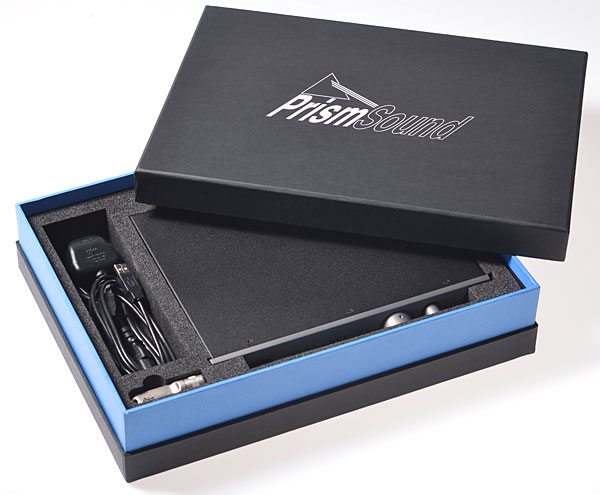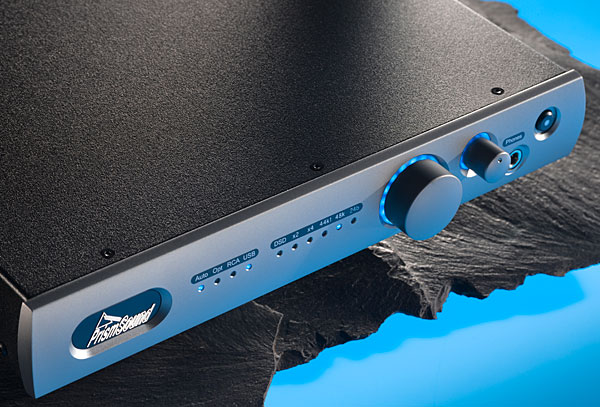| Columns Retired Columns & Blogs |
Prism Sound Callia D/A headphone amplifier

I have long been aware of English audio company Prism Sound, both from my use at the turn of the century of their excellent PCI card–based DScope2 measurement system (footnote 1), and from some of my friends' enthusiasm for Prism's SADiE digital audio workstation. Prism Sound was founded in 1987 by two DSP engineers, Graham Boswell and Ian Dennis, who had first met when working at mixing-console manufacturer Rupert Neve, in Cambridge, England. From the beginning, Prism Sound operated exclusively in the world of professional audio, but a year or so ago I began seeing their first domestic audio product, the Callia, at audio shows.
Footnote 1: Prism's current measurement system is the standalone DScope Series III.
Description
Priced at $2750, the Callia is a PCM- and DSD-capable D/A processor and headphone amplifier with separate volume controls for its line and headphone outputs. A slim design with a gray-anodized front panel and a black-painted steel case, the Callia has pairs of balanced and single-ended outputs on the rear, and a ¼" stereo headphone output on the right of the front panel. The two volume controls are flanked by circular arrays of blue LEDS; the larger array for the primary control successively illuminate as the volume is increased. (The brightness of the LEDs is adjustable.) The line volume control can be disabled for use with external preamplifiers, and the line outputs can be muted when headphones are used.

The rear panel also has coaxial and optical S/PDIF inputs and a USB port, but peculiarly, given its pro heritage, no AES/EBU input. Blue LEDS on the front panel indicate: which source is active (source selection can be automatic or manual), bit depth (24 when lit), and sample rate. The bit rate is displayed by the illumination of one of two LEDs for 44.1 or 48kHz, and LEDs for "x2" and "x4." For example, a source sampled at 352.8kHz would cause the "44k1," "x2," and "x4" LEDs all to be lit. A separate LED indicates when DSD data are being received via USB.
A right-hand button switches the Callia in and out of standby mode and can also be used to manually select the source. (The Callia has no remote control.) A DIP switch on the rear panel allows the headphone output level to be optimized for headphones of high, medium, or low impedance, enables/disables the main volume control, and allows for there to be 3.1dB of digital headroom with DSD data (the default), or 0dB headroom, the latter giving a noise floor 3.1dB lower.
The DAC circuits are said to be identical to those in Prism Sound's Lyra, Titan, and Atlas professional converters, and appear to be based on a pair of Cirrus Logic CS4398 DAC chips: an oversampled, multi-bit, sigma-delta type that will operate at sample rates of up to 192kHz. While the Callia will accept data sampled at 352.8 and 384kHz, it downsamples these to 192kHz before sending them to the DAC, using what Prism says is a "high precision digital interpolation filter." It also converts DSD64 and DSD128 data to PCM, Prism stating that this lets them achieve exactly the response they want "using [a] suitable silicon budget to doing a really nice job of it," and adding that they've been researching such processing and conversion technologies "since the earliest days of DSD."

The main integrated circuits on the printed circuit board that occupies the Callia's full width and depth are an ARM microprocessor, Texas Instruments 2933 phase-locked-loop (PLL) chips, and a Xilinx Spartan-6 FPGA. A shielded power supply occupies the right-hand side of the PCB, Prism saying that the analog circuitry is galvanically isolated from the power supply and digital circuitry, to eliminate interference. The analog output stages appear to be based on classic low-distortion NE5532A op-amp chips, and a short vertical metal shield separates the left and right output circuits.
Critical to the performance of a D/A processor is the quality not only of its master clock but how well it rejects timing uncertainty—jitter—in the incoming datastream. Prism Sound calls its solution CleverClox, a hybrid PLL circuit that allows a low-jitter clock to be re-created from the incoming data "no matter how much jitter it has and no matter what its frequency."
Sound on the Desktop
For use with Windows PCs, the Callia's USB 2.0 input requires a driver program; this and the pdf manual are supplied on a USB stick. USB 2.0 is supported natively by Macs running OS X, so no driver software need be installed; nonetheless, Prism recommends installing its software on Macs to permit firmware updates.
I used the Callia for desktop listening with my Audeze LCD-X headphones, the Pure Music app on my MacBook Pro sending it data via USB. The balance was on the warm side; "Fisherman's Daughter," from Daniel Lanois's Acadie: Gold Top Edition (ALAC rip from CD, Red Floor ?FNCD5543), sounded richer than I expected. The spacey accompaniment in "Silium's Hill," however, wasn't rolled off or indistinct; and David Abel's violin in his recording of Beethoven's Violin Sonata 10 in G, Op.96 No.1, sounded natural, with no high-frequency tizz, while Julie Steinberg's piano sounded rich (24/192 ALAC needle drop from LP, Wilson Audio W-8315).

Sound in the Big Rig
I installed the Callia in place of my reference DAC, PS Audio's PerfectWave DirectStream ($6899 with Bridge II network adapter card), which I was using without preamp to directly feed my Lamm M1.2 Reference monoblocks. The Callia presented somewhat less soundstage depth than the DirectStream. My recording of clarinetist Antony Michaelson leading a string quartet in Brahms's Clarinet Quintet (16/44.1 ALAC file from CD, Stereophile STPH015-2) was made in Chad Kassem's Blue Heaven Studios, in Salina, Kansas, with the microphones relatively close to the musicians. The acoustic of that former church is thus fairly subtle, but through the PS Audio was sufficiently supportive of the ensemble. But with the Callia, the acoustic seemed somewhat suppressed; I began to feel that I should have moved the mikes a tad farther away.

The Callia's slightly dry sound was not a problem with non-classical recordings. With the superbly well-recorded DVD-A of XXL, by Gordon Goodwin's Big Phat Band (Silverline 284104-2, a disc loaned me by reader Rush Selden), the Callia preserved the power and impact of the bass and drums, the goopy soupiness of the saxes, the brassy blattiness of the horns, and the tonally exaggerated close harmony and scatting of Take 6—all were present in full measure. As I had no preamp in the system, I was feeding the Callia 16/48 S/PDIF data from my Ayre Acoustics C-5xeMP player via an antique Meridian 518 format converter (with its DSP bypassed) to convert the player's AES/EBU output to S/PDIF. However, when I next went to play XXL, the sound was louder, drier, edgier. What the . . . ?
I ejected the disc and saw that I'd inserted it in the player upside down—and because it's a DualDisc, its flip side is a CD: I was listening to 16/44.1 data. The difference in sound quality was greater than I would have expected from the sample rates, even after adjusting the volume for the ca 6dB greater average level of the CD version. But as I have no way of knowing how the two versions were prepared, perhaps the CD had been poorly transcoded as well as being compressed.
After a few weeks of living with the Callia, and to prepare to write my review of this issue's MQA-encoded "Recording of the Month," I replaced the Callia with the Mytek Brookyn, which cost $1995 before it was replaced by the Brooklyn DAC+ ($2195; see Jim Austin's review of the DAC+ elsewhere in this issue). Before reinserting the Callia in the system to finish its review, I repeated the Gordon Goodwin comparison with the Mytek. Level differences aside, the CD side now sounded a little closer to the DVD-A side. Of more significance to me, the Mytek better reproduced the space of the Kansas church building in which I'd recorded the Brahms Clarinet Quintet.

Conclusions
I appreciated the fact that the Prism Sound Callia has a volume control, which meant that I could connect it directly to my power amplifiers and not have to use a preamplifier. But I missed having a remote control to adjust volume—and the way my system is now configured, DACs work best for me when connected via Ethernet to the host computer rather, than the Callia's USB input.
The Callia is, without a doubt, an excellent-sounding DAC, if not quite scaling the heights of more expensive products such as Ayre's QX-5 Twenty ($8950), Chord's DAVE ($12,488), and MBL's N31 ($15,400). But at $2750 it comes under stiff competition from Mytek's Brooklyn DAC+ and Benchmark's DAC3 HGC, both of which offer very similar functionality and footprint and retail for the same $2195. I heard the Benchmark only briefly in my system, but the original version of the Brooklyn is both more versatile, in that it has MQA decoding, and has slightly better sound quality. This is where you, Dear Reader, will need to listen for yourself; your choice of DAC will, more than usual, depend on your own tastes and needs.
Footnote 1: Prism's current measurement system is the standalone DScope Series III.
- Log in or register to post comments




































